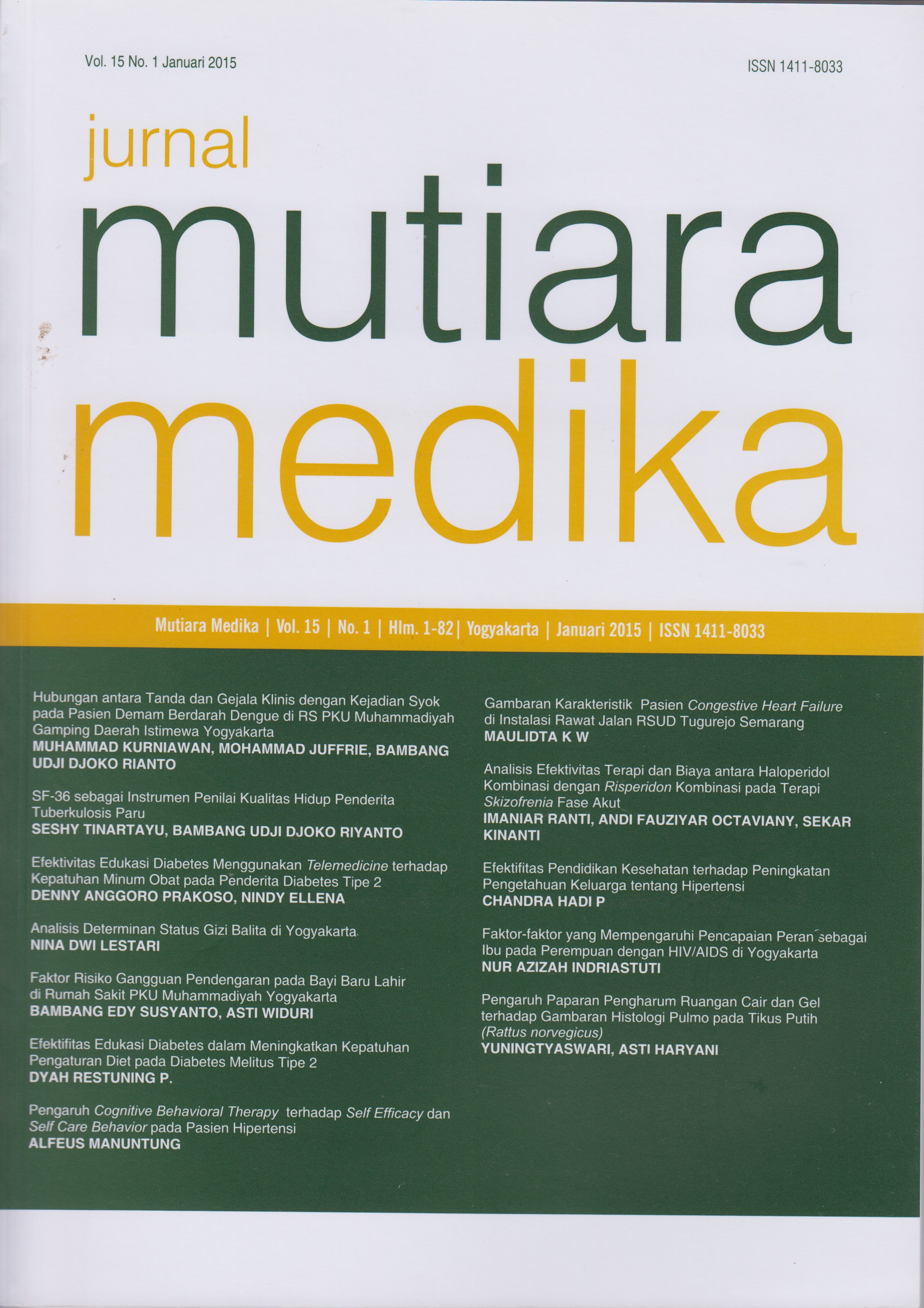Faktor Risiko Gangguan Pendengaran pada Skrining Pendengaran Bayi Baru Lahir di Rumah Sakit PKU Muhammadiyah Yogyakarta
DOI:
https://doi.org/10.18196/mmjkk.v15i1.2491Keywords:
neonatus, sensory hearingloss, risk factor, early detection, OAE, tuli sensori, faktor risiko, deteksi diniAbstract
Jenis ketulian neonatus yang banyak dijumpai adalah sensori. Upaya habilitasi hanya dengan memasang alat bantu dengar dan melatih dengan metode audiovisual. Habilitasi sangat efektif bila dilakukan pada periode perkembangan bicara anak sekitar usia 9 bulan sampai 3 tahun. Untuk itu perlu dideteksi dini adanya ketulian pada neonatus, dan segera dimulai habilitasi pendengaran. Penelitian ini untuk mengetahui frekuensi jenis faktor risiko yang potensial penyebab ketulian neonatal. Penelitian ini menggunakan rancang penelitian potong lintang, dengan menggunakan alat otoacoustic emission (OAE) untuk deteksi ketulian neonatus yang lahir antara bulan Januari dan December 2014 di RS PKU Muhammadiyah. Faktor risiko di lihat dalam rekam medik, data dianalisis menggunakan chi-square. Faktor risiko ketulian yang paling banyak adalah hiperbilirubin sejumlah 44 (53.0%) kasus, prematuritas sejumlah 30 (36.1%) kasus, ventilasi mekanik sejumlah 27 (32.5%) kasus, dan BBLR sejumlah 16 (19.3%). Uji statistik chi-square menunjukkan p=0,001 pada risiko BBLR. Disimpulkan BBLR menjadi salah satu risiko gangguan pendengaran pada skrining pendengaran bayi baru lahir.
The most common congenital neonatus hearing loss is sensory disorder. The habilitation is wearing hearing aids, and audiovisual training. Effective habilitation if perform at optimal early childhood speech development around 9 month to 3 years old. For this reason need early neonatus hearing detection and habilitation. The aims to know the frequency and potential of neonatal hearing loss risk factors. The method by cross sectional method newborns were tested with OAE screening test, between Januari 2014 and December 2014 in PKU Muhammadiyah Hospital. From medical report all risk factors data and analyzed by chi-square. Most hearing impairment risk factors are hyperbilirubinemia 44 (53.0%) cases, prematurity 30 (36.1%) cases, mechanical ventilation 27 (32.5%) cases, and low birth weight LBW 16 (19.3%) cases. By chi-square shown p=0,001 for low birth weight. LBW as one of risk factor to hearing impairment at newborn hearing screening.
References
Anonym. American Academy of Pediatrics; Joint Committee on Infant Hearing. Year 2007 Position Statement: Principles and Guidelines for Early Hearing Detection and Intervention Programs. Pediatrics, 2007; 120 (4): 898-921.
Garcia MV, Azevedo MF, Testa JR. Acoustic Immitance Measures in Infants with 226 and 1000 Hz Probes: Correlation with Otoacoustic Emissions and Otoscopic Examination. Braz J Otorhinolaryngol, 2009; 75: 80-89 3.
Bashirudin, J. Newborn Hearing Screening in Six Hospital in Jakarta and Surroundings. Maj Kedokt Indon, 2009; 59 (2): 51-54.
Perkins, N. Early Detection and Diagnosis of Infant Hearing Impairment dalam CW Cummings, PW Flint, BH Haughey, KT Robbins, JR Thomas, LA Harker & MA Richardson, eds. Philadelphia: Otolaryngology: head & neck surgery, Mosby, Inc. 2005.
da Silva DPC, Martins RHG. Analysis of Transient Otoacoustic Emissions and Brainstem Evoked Auditory Potentials in Neonates with Hyperbilirubinemia. Braz. j. otorhinolaryngol. 2009; 75 (3): 381-386.
Oysu C, Aslan I, Ulubil A, Baserer N. Incidence of Cochlear Involvement in Hyperbilirubinemic Deafness. Ann Otol Rhinol Laryngol, 2002; 111 (11): 1021-25.
Joviolo GR. Prematuritas sebagai Faktor Risiko Gangguan Fungsi Sel Rambut Luar Kokhlea. Disertasi Bagian Ilmu Kesehatan THT, Universitas Gadjah Mada, Yogyakarta. 2013.
Reiman M, Parkkola R, Johansson R, Jääskeläinen SK, Kujari H, Lehtonen L, et al. Diffusion Tensor Imaging of the Inferior Colliculus and Brainstem Auditory-Evoked Potentialisin Preterm Infant. Pediatr Radiol, 2009; 39 (8): 804-809.
Cristobal, R. & Oghalai, J.S., Hearing Loss in Children with Very Low Birth Weight: Current Review of Epidemiologyand Pathophysiology. Arch Dis Child Fetal Neonatal, 2008; 93 (6): 462-468.
Karaca CT, Oysu C, Toros SZ. Naiboglu N, Verim A. Is Hearing Loss in Infants Associated with Risk Factors? Evaluation of the Frequency of Risk Factors. Clin and Exp Otorhinolaryngol, 2014; 7 (4): 260-263.
Baradaranfar MH, Mehrparvar AH, Mostaghaci M, Mollasadeghi A, Naghshineh E, Davari MH. Hearing Abnormality in Neonate Intensive Care Unit (NICU), Yazd-Iran. International Journal of Pediatrics, 2014; 2 (5): 113-117.
Downloads
Issue
Section
License
Copyright
Authors retain copyright and grant Mutiara Medika: Jurnal Kedokteran dan Kesehatan (MMJKK) the right of first publication with the work simultaneously licensed under an Attribution 4.0 International (CC BY 4.0) that allows others to remix, adapt and build upon the work with an acknowledgment of the work's authorship and of the initial publication in Mutiara Medika: Jurnal Kedokteran dan Kesehatan (MMJKK).
Authors are permitted to copy and redistribute the journal's published version of the work (e.g., post it to an institutional repository or publish it in a book), with an acknowledgment of its initial publication in Mutiara Medika: Jurnal Kedokteran dan Kesehatan (MMJKK).
License
Articles published in the Mutiara Medika: Jurnal Kedokteran dan Kesehatan (MMJKK) are licensed under an Attribution 4.0 International (CC BY 4.0) license. You are free to:
- Share — copy and redistribute the material in any medium or format.
- Adapt — remix, transform, and build upon the material for any purpose, even commercially.
This license is acceptable for Free Cultural Works. The licensor cannot revoke these freedoms as long as you follow the license terms. Under the following terms:
Attribution — You must give appropriate credit, provide a link to the license, and indicate if changes were made. You may do so in any reasonable manner, but not in any way that suggests the licensor endorses you or your use.
- No additional restrictions — You may not apply legal terms or technological measures that legally restrict others from doing anything the license permits.






